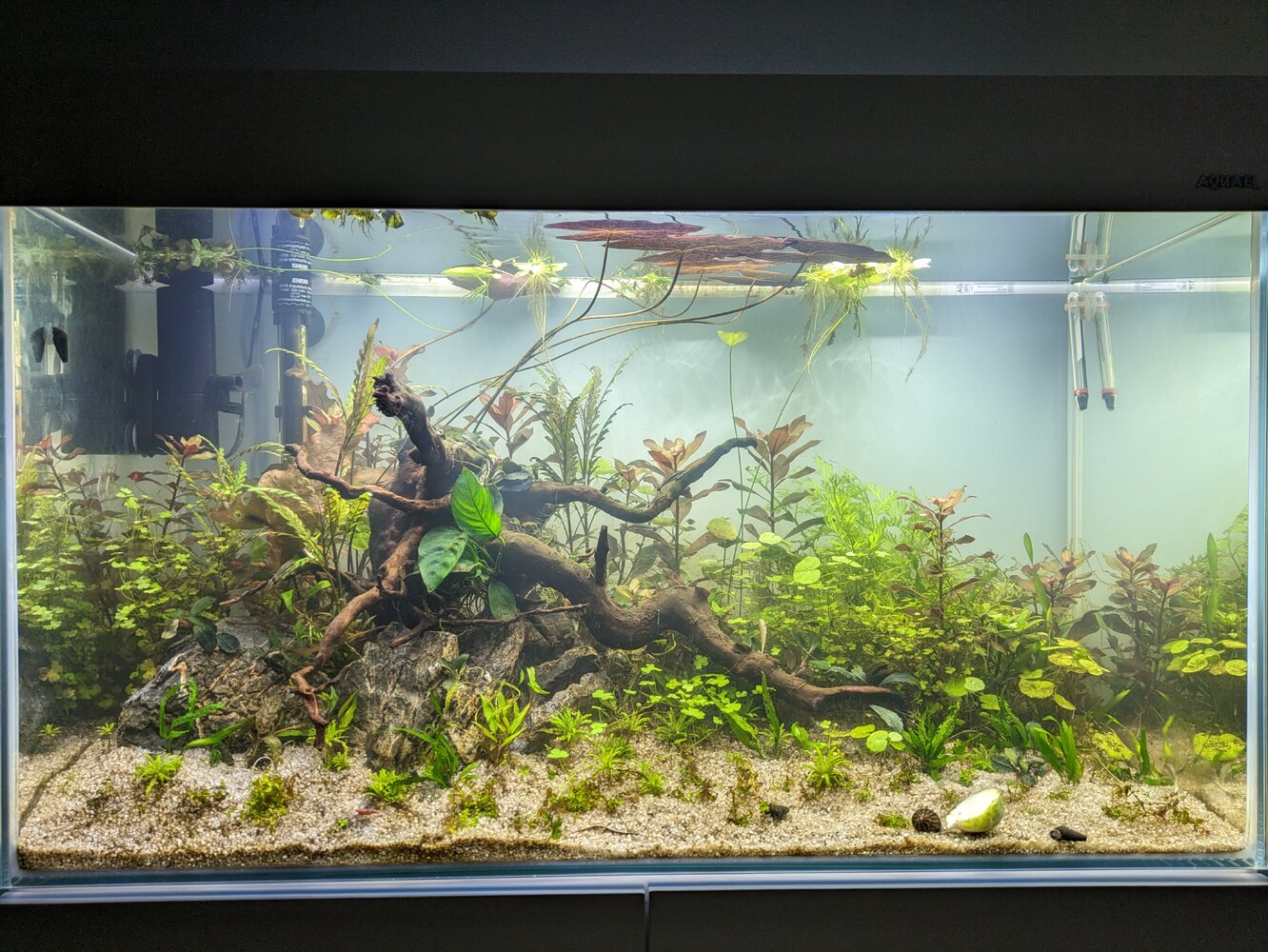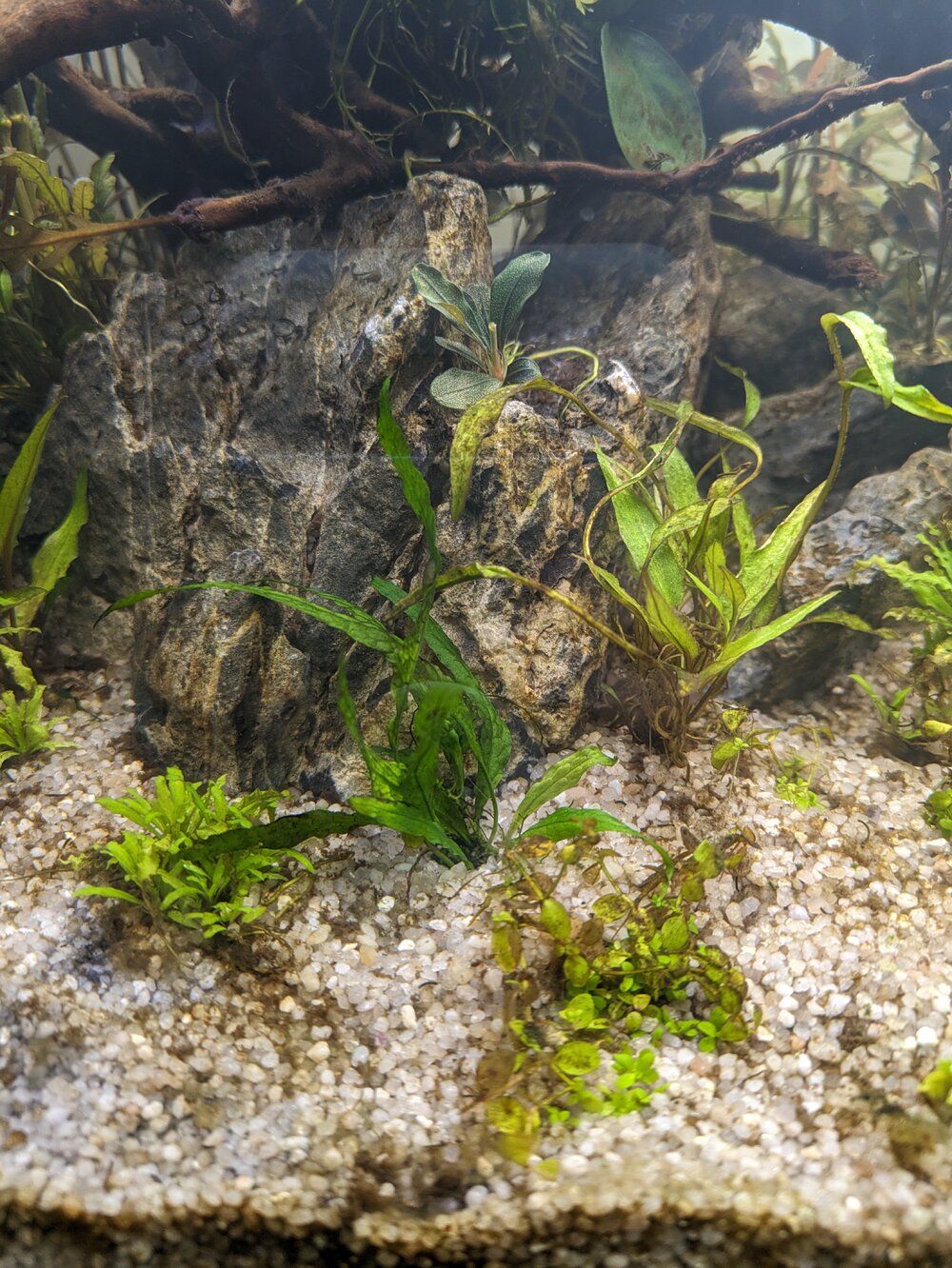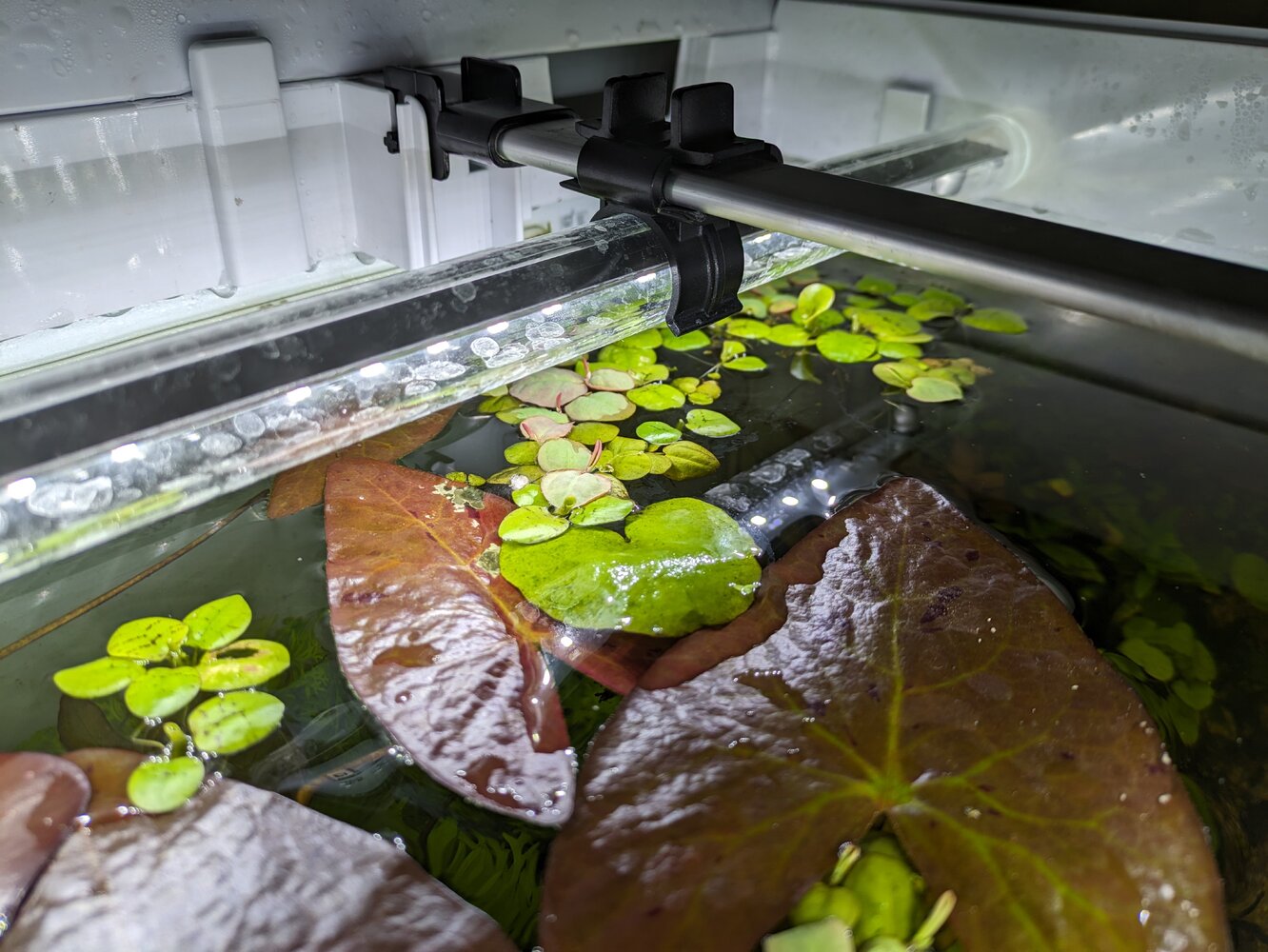A filter - it's a surface skimmer so water from the surface should be being turned over, although I've stuffed it with some filter floss to prevent the shrimp getting sucked in which has slowed it down a little.Oxygen is always helpful, for shrimps in particular. Do you employ any kind of oxygenation?
-
You are viewing the forum as a Guest, please login (you can use your Facebook, Twitter, Google or Microsoft account to login) or register using this link: Log in or Sign Up
You are using an out of date browser. It may not display this or other websites correctly.
You should upgrade or use an alternative browser.
You should upgrade or use an alternative browser.
My first adventure into aquascaping - Aquael 125L Walstad
- Thread starter Katharine
- Start date
Lost 2 shrimp now. The others seemed to cope better with the transition so I hope that will be the last of the losses for a while. I will be much more careful about acclimation and stocking choices from now on. 
On a happier note, I enjoyed seeing one of my snails bury themselves in the substrate:

Algae wise I'm moving into a new phase, green algae of gradually increasing thickness is covering the glass. The shrimp and snails are not a match for it, I need to buy an algae scraper.
I've been wondering how to tell whether my plants are growing well - more specifically are they growing fast enough? I've got both lights on again now for most of two blocks of 4 hours of light to see if that helps.
On a happier note, I enjoyed seeing one of my snails bury themselves in the substrate:
Algae wise I'm moving into a new phase, green algae of gradually increasing thickness is covering the glass. The shrimp and snails are not a match for it, I need to buy an algae scraper.
I've been wondering how to tell whether my plants are growing well - more specifically are they growing fast enough? I've got both lights on again now for most of two blocks of 4 hours of light to see if that helps.
I got 6 otocinclus and 6 celestial pearl danios and a hitchhiker snail today! So excited. 
They are drip acclimating as I write this. I read lots of contradictory information about whether drip acclimation is a good idea, which has been worrying me, so I've tested the water in one of the bags for ammonia and it's reading zero. I've also checked the general hardness of the water the otos are in and it's very similar to mine, so hopefully they will transition well. 🤞 There's lots of algae in my tank but I've also got an array of different food options for the otos, and I've got some NTLABS micro crumb for the CPDs (they are tiny right now!).
They are drip acclimating as I write this. I read lots of contradictory information about whether drip acclimation is a good idea, which has been worrying me, so I've tested the water in one of the bags for ammonia and it's reading zero. I've also checked the general hardness of the water the otos are in and it's very similar to mine, so hopefully they will transition well. 🤞 There's lots of algae in my tank but I've also got an array of different food options for the otos, and I've got some NTLABS micro crumb for the CPDs (they are tiny right now!).
Absolutely in love with these little guys!



The otos are making fast work of the algae - the glass is already looking very clean and as you can see they've made a start on the biofilm on the wood! I've got some alternative food options lined up, including some soilent green courtesy of @aec34!
I haven't got any photos yet of the CPDs - they have been starting to explore but are quite shy so far! I'm planning to get another 6 CPDs next weekend to keep them company.
Also if I'm honest the otos are my favourite! I've wanted to keep them for years and they've already absolutely exceeded my expectations.
The otos are making fast work of the algae - the glass is already looking very clean and as you can see they've made a start on the biofilm on the wood! I've got some alternative food options lined up, including some soilent green courtesy of @aec34!
I haven't got any photos yet of the CPDs - they have been starting to explore but are quite shy so far! I'm planning to get another 6 CPDs next weekend to keep them company.
Also if I'm honest the otos are my favourite! I've wanted to keep them for years and they've already absolutely exceeded my expectations.
Also today - I added some great plants from @Courtneybst. Lots of bucephalandra a tiny sword and Cryptocoryne Nurii 'Rosen Maiden'.
Attaching the bucephalandra was harder than the YouTubers make it look but I think I've done an acceptable job at least for a first attempt.
The sword is such a lush green compared to all my other plants, it makes me think mine must have some kind of deficiency - any thoughts?
Admittedly it's only been 24 hours since adding fish but nitrates are still very low/close to undetectable.
Attaching the bucephalandra was harder than the YouTubers make it look but I think I've done an acceptable job at least for a first attempt.
The sword is such a lush green compared to all my other plants, it makes me think mine must have some kind of deficiency - any thoughts?
Admittedly it's only been 24 hours since adding fish but nitrates are still very low/close to undetectable.
Attachments
Last edited:
Courtneybst
Member
Just a heads up, don't bury the rhizomes of the Microsorum or bucephalandra, else they're likely to rot away.
Ah thanks! The buce isn't buried but didn't realise that applies to the microsorum too - will fix!Just a heads up, don't bury the rhizomes of the Microsorum or bucephalandra, else they're likely to rot away.
What's your secret for making them so green? I'm assuming CO2 and fertilisers haha. 😅
Last edited:
Courtneybst
Member
I don't think I have a secret per se, but I guess just a balance of nutrients/light/CO2 appropriate for the environment. Higher on all 3 factors if it's CO2 injected, lower if it's not. Didn't really do much else!Ah thanks! The buce isn't buried but didn't realise that applies to the microsorum too - will fix!
What's your secret for making them so green? I'm assuming CO2 and fertilisers haha. 😅
Hi all,
Have a look at @Parablennius <"Floaters"> thread.
I choose a floating plant for the <"Duckweed Index"> - <"Echinodorus bleheri - slow growth">, because "floating" takes CO2 availability out of the equation.
I stopped using Lesser Duckweed (Lemna minor) because <"it doesn't like low nutrients or soft water">, but Amazon Frogbit (Limnobium laevigatum) is a "Duckweed" <"without these disadvantages">.
At some point I'm going to try the <"VIMI"> method where I mix Red-root Floater (Phyllanthus fluitans) with the Frogbit. I've owned Phyllanthus a <"couple of times">, but it <"has never enjoyed life with me">.
cheers Darrel
Assuming that your plants have all the <"14 essential mineral nutrients">? Then it is largely a nitrogen effect <"Black leaf edges - cause?">.What's your secret for making them so green? I'm assuming CO2 and fertilisers
Have a look at @Parablennius <"Floaters"> thread.
I choose a floating plant for the <"Duckweed Index"> - <"Echinodorus bleheri - slow growth">, because "floating" takes CO2 availability out of the equation.
I stopped using Lesser Duckweed (Lemna minor) because <"it doesn't like low nutrients or soft water">, but Amazon Frogbit (Limnobium laevigatum) is a "Duckweed" <"without these disadvantages">.
At some point I'm going to try the <"VIMI"> method where I mix Red-root Floater (Phyllanthus fluitans) with the Frogbit. I've owned Phyllanthus a <"couple of times">, but it <"has never enjoyed life with me">.
cheers Darrel
Last edited:
I've got some red root floaters mixed in with my frogbit, maybe I can share some photos!Hi all,
Assuming that your plants have all the <"14 essential mineral nutrients">? Then it is largely a nitrogen effect <"Black leaf edges - cause?">.
Have a look at @Parablennius <"Floaters"> thread.
I choose a floating plant for the <"Duckweed Index"> - <"Echinodorus bleheri - slow growth">, because "floating" takes CO2 availability out of the equation.
I stopped using Lesser Duckweed (Lemna minor) because <"it doesn't like low nutrients or soft water">, but Amazon Frogbit (Limnobium laevigatum) is a "Duckweed" <"without these disadvantages">.
At some point I'm going to try the <"VIMI"> method where I mix Red-root Floater (Phyllanthus fluitans) with the Frogbit. I've owned Phyllanthus a <"couple of times">, but it <"has never enjoyed life with me">.
cheers Darrel
What I'm wondering is how do I know my plants have all the 14 essential nutrients? How do I know if they don't have enough nitrogen? And what are my options are if they don't?
_Maq_
Member
It's not as difficult as it seems at the first spot. Very likely, majority of them will never get short.What I'm wondering is how do I know my plants have all the 14 essential nutrients?
There are, unfortunately, two big unknowns which prevent you from systematic approach: 1) your tap water with unknown content of various minerals, 2) your 'Walstad' soil, again, unknown source of nutrients.
@dw1305's Duckweed index is a good method, I think. Be it duckweed or any other species, you'll have to observe your plants and seek signs of deficiency.How do I know if they don't have enough nitrogen?
Again, if you don't intend to fully embrace the 'science', @dw1305's method is not bad: Use complete (hydroponic) fertilizer with balanced contents of all nutrients. Later on, you'll probably see that you'll need a specific iron fertilizer. That's about all.And what are my options are if they don't?
Hi all,
cheers Darrel
We like photos. Have a look at @jameson_uk 's Frogbit threads <"Iron deficiency and which chelator do I need?"> from the link.I've got some red root floaters mixed in with my frogbit, maybe I can share some photos!
What @_Maq_ & @AlecF say.What I'm wondering is how do I know my plants have all the 14 essential nutrients? How do I know if they don't have enough nitrogen? And what are my options are if they don't?
The problem is that it really difficult to get accurate parameter for many of the nutrients we are interested in. Water companies have <"analytical labs"> with hundreds of <"thousands of pounds worth of kit"> and dedicated scientists that can use it, so they should be able to give you an accurate water report.posting from London you should be able to get a rough profile of your water easily.
<"Unscrupulous companies"> will sell you test kits for dissolved oxygen (DO), nitrate (NO3), iron (Fe), magnesium (Mg) etc. but they know they are, <"at best, compromised"> and in many cases <"totally useless">, they <"just want your money">, they aren't interested in whether their products work or not.Both <"Estimative"> and <"Duckweed"> indices, even though they are very different in concept, and were developed entirely independently, were designed to do away with the need for accurate water testing. This was just a reflection <"of the difficulties involved"> with accurate water testing.
Both Tom Barr (@plantbrain ) and myself <"worked in situations"> where we had access to analytical equipment, and could get accurate values for many water parameters, but we recognised that methods <"that didn't rely on water testing"> were more likely to <"provide successful solutions"> in the long run.
It would be fair to say that Tom and I, even though we are both loosely Plant Scientists, have <"very different approaches"> to our jobs.
cheers Darrel
Okay here are some photos -



There's a mix of frogbit (added a week ago), red root floaters, tiger lotus and a lily.
I'm still adding a small amount of iron everyday.
I can definitely lookup my water company's report - which nutrients should I look out for and what's considered high/low?
My LFS made a comment relating to algae implying perhaps the water is quite high in certain nutrients -don't remember which ones - but the last couple of weeks I've only been adding dehumidifier water as I gradually drop the water hardness to the level I want it, which shouldn't contain any nutrients.
There's a mix of frogbit (added a week ago), red root floaters, tiger lotus and a lily.
I'm still adding a small amount of iron everyday.
I can definitely lookup my water company's report - which nutrients should I look out for and what's considered high/low?
My LFS made a comment relating to algae implying perhaps the water is quite high in certain nutrients -don't remember which ones - but the last couple of weeks I've only been adding dehumidifier water as I gradually drop the water hardness to the level I want it, which shouldn't contain any nutrients.
Attachments
_Maq_
Member
Once you get it we can discuss it.I can definitely lookup my water company's report - which nutrients should I look out for and what's considered high/low?
_Maq_
Member
This is a chart I'm using. My water (RO+DI mineralized) is added for comparison:

What to say about your water? Me, I'd outright dismiss it as useless because I want to keep demanding plants, and don't help it with CO2 injection.
You were worried about nutrients. Firstly, there's a plenty of nitrogen in your tap water. Magnesium is relatively low against calcium; that might be a problem. I don't like the high content of sodium, but it does not present an unsurmountable problem for hardy species. Your data do not specify potassium and phosphates. They are present, most likely, but in small amounts. Generally, your water is very hard and very alkaline. That means it will always tend to remain basic (pH > 7), and that means in turn that you'll have to dose iron through advanced chelates (EDTA may be insufficient).
Still, it is possible to have a planted aquarium with a water like this. Only some sensitive species (requiring soft, acidic water) won't grow there.
What to say about your water? Me, I'd outright dismiss it as useless because I want to keep demanding plants, and don't help it with CO2 injection.
You were worried about nutrients. Firstly, there's a plenty of nitrogen in your tap water. Magnesium is relatively low against calcium; that might be a problem. I don't like the high content of sodium, but it does not present an unsurmountable problem for hardy species. Your data do not specify potassium and phosphates. They are present, most likely, but in small amounts. Generally, your water is very hard and very alkaline. That means it will always tend to remain basic (pH > 7), and that means in turn that you'll have to dose iron through advanced chelates (EDTA may be insufficient).
Still, it is possible to have a planted aquarium with a water like this. Only some sensitive species (requiring soft, acidic water) won't grow there.
Hi all,
Cheers Darrel
Pretty typical for SE. England, hard and alkaline with a lot of nutrients.Here you go -
Cheers Darrel
Thank you! I am diluting the water so these numbers should all go down (aiming for 10 dGH as the lowest I think I can go without upsetting the snails - 1 nerite and 3 black panther snails).This is a chart I'm using. My water (RO+DI mineralized) is added for comparison:
View attachment 213237
What to say about your water? Me, I'd outright dismiss it as useless because I want to keep demanding plants, and don't help it with CO2 injection.
You were worried about nutrients. Firstly, there's a plenty of nitrogen in your tap water. Magnesium is relatively low against calcium; that might be a problem. I don't like the high content of sodium, but it does not present an unsurmountable problem for hardy species. Your data do not specify potassium and phosphates. They are present, most likely, but in small amounts. Generally, your water is very hard and very alkaline. That means it will always tend to remain basic (pH > 7), and that means in turn that you'll have to dose iron through advanced chelates (EDTA may be insufficient).
Still, it is possible to have a planted aquarium with a water like this. Only some sensitive species (requiring soft, acidic water) won't grow there.
The iron definitely seemed to resolve the issues I was having with very pale plants and dying frogbit so I think it must be working.
Maybe it's worth trying magnesium next in that case? Do you think I could use magnesium citrate? I have some supplements lying around.
I can't find the units for ammonia/nitrite/nitrate for my test kit - are they likely to be the same (mg/l)?
It's interesting that pH, dGH and dKH are all lower than what I measured on 26/10 - pH 8.5, ~13.5 dKH, ~18.5 dGH





